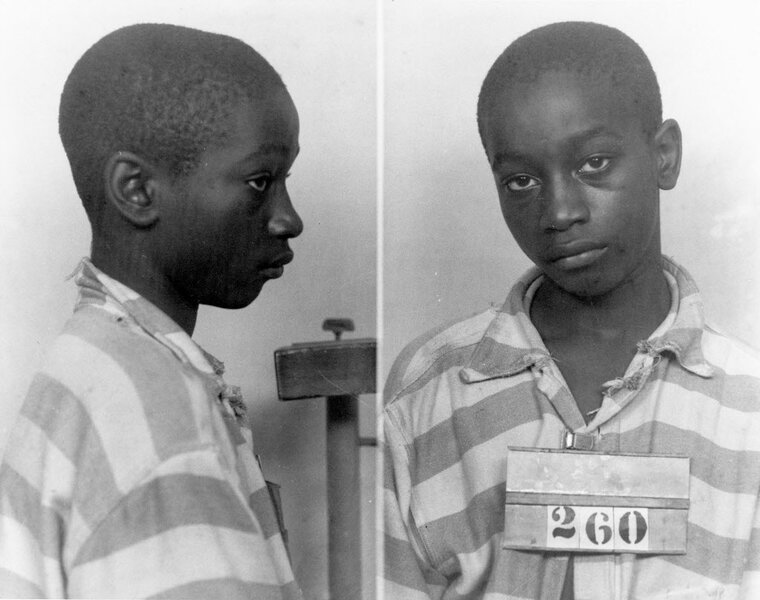South Carolina court mulls retrial of 14-year-old in Jim Crow-era murder case
Loading...
In the summer of 1944 in a South Carolina mill town, a 14-year-old black child was electrocuted as the convicted murderer of two white girls. He remains the youngest person to be executed in the US since the 1800s.
For almost seven decades, George Stinney’s trial and execution – swiftly carried out in a Southern town that was weathering a troubled road to desegregation – has been a quiet blight on South Carolina’s historical record. His family had put him in an unmarked grave, and, they have said, tried to forget what happened.
At least, they have until now. In two days of hearings this week, lawyers representing George’s family presented arguments to a state judge that the teenager, should be given a new trial 70 years after his execution. His surviving siblings have said that 1944 trial was so badly handled, so fouled by racist politics, that their brother should not have been convicted. They have also provided evidence that the teenager was innocent of the grisly murders.
Though there is general agreement that the child’s trial and execution were not in keeping with modern standards, at issue is if the 1944 trial should be, and can be, revisited with modern legal procedure. George’s siblings have said that a 2014 trial is a chance to give their brother a long-overdue chance at justice, at least in name. Opponents, though, have said there is little use in revisiting the case , even if it was a gross miscarriage of justice.
Circuit Court Judge Carmen Mullen adjourned the hearing on Wednesday without ruling on the trial request. She said she would give the state prosecutor at least 10 days to review the proceedings, and she would issue a ruling sometime afterward.
George was convicted in 1944 of killing 11-year-old Betty Binnicker and 7-year-old Mary Emma Thames, two white girls. He had been part of the search parties that found the young children’s beaten bodies in a ditch in the rural hometown all three shared: Alcolu, a hard-up town etched with Jim Crow laws.
George's trial lasted three hours. No witness for the defense were called and no evidence that could exonerate him was presented. Prosecutors said that George had confessed to the murders during interrogation – a confession that has since disappeared. An all-white jury took 10 minutes to convict him, CNN reported.
The teenager was executed in the electric chair a month later. His father, fired from his mill job, gathered the family and moved 15 miles to an adjacent town, Pinewood.
Since then, almost all the original evidence in the trial has gone missing, and lawyers for the family have had to cull new evidence to press their case for a new one.
In hearings this week, three of George’s siblings testified that their brother had been with the family on the day the two murdered girls went missing and could not have committed the crime. They also said that their brother was petrified of white officials and would have confessed to a crime he didn’t commit under duress.
A psychiatrist called on the family’s behalf also told the judge that George’s confession was inconsistent with the evidence, calling it a “a coerced, compliant, false confession,” according to NBC News.
Still, the effort to understand what happened in 1944 has in large part had to rely on the fallible, at times spotty, memories of the people present for those troubled days. One of the siblings fumbled during cross-examination when she couldn’t remember the specifics of a 2009 statement she had given, prompting questions about whether a trial could proceed on decades-old memories, the Associated Press reported.
The effort to bring the case to trial has met opposition from the state and relatives of the murdered girls. Both have argued that the proposed trial would be a fruitless exercise, dredging up a case that was a nasty product of its time and that no do-over can change. They also say that allowing a trial to go ahead would set a precedent for allowing possibly hundreds of similarly botched, old cases to be returned to courtrooms.
“Back in 1944, we should have known better, but we didn’t,” Mr. Finney, who is representing the state’s opposition, told The New York Times. “The fact of the matter is, it happened, and it occurred because of a legal system of justice that was in place.”
Frankie Dyches, the niece of one of the murdered girls, told the judge that she remained convinced of George’s guilt.
‘‘He confessed,” she said, the Associated Press reported. “I think it needs to be left as it is.”
But supporters of a new trial say that there is good reason for returning to a highly emotional case in a state still coming to terms with its past.
"We think we have the opportunity here to make a difference and correct a wrong that's been there for 70 years," defense attorney Matt Burgess told CNN. “South Carolina still recognizes George Stinney as a murderer. We felt that something needed to be done about that."








